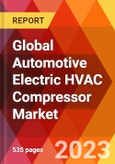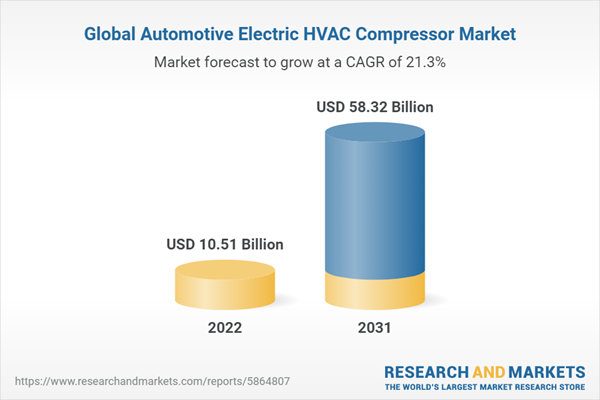The global automotive electric HVAC compressor market held a market value of US$ 10.51 Billion in 2022 and is estimated to reach US$ 58.32 Billion by the year 2031. The market value is projected to list a CAGR of 21.33% during the forecast period. The market volume in 2022 was 30442.71 thousand units, and is expected to grow at a rate of 30.85% over the forecast period.The global automotive electric HVAC compressor market held a market value of US$ 10.51 Billion in 2022 and is estimated to reach US$ 58.32 Billion by the year 2031
With the rise of electric vehicles (EVs), the demand for efficient and reliable HVAC systems has increased significantly. Electric HVAC compressors are becoming increasingly popular in EVs due to their energy efficiency, reliability, and compact size. Unlike traditional HVAC systems that rely on a belt-driven compressor, electric HVAC compressors use an electric motor to compress refrigerant gases, which makes them more efficient and reliable. Manufacturers are investing in research and development to improve the performance and reliability of these systems, and this is expected to drive continued growth in the market in the coming years.
Growth Influencers:
Growing Focus on Controlling Interior Thermal Environment of Vehicles to Ensure Safety and ComfortThe growing focus on controlling the interior thermal environment of vehicles to ensure safety and comfort is a significant driver for the automotive electric HVAC compressor market. HVAC (Heating, Ventilation, and Air Conditioning) systems are essential components in modern vehicles, and they play a critical role in maintaining a comfortable and safe interior environment. In addition to improving energy efficiency, electric HVAC compressors also provide greater control over the interior thermal environment of vehicles. They can quickly and accurately adjust the temperature and humidity levels in the cabin, which helps to ensure passenger comfort and safety. The growing demand for electric vehicles and the need for efficient and reliable HVAC systems are driving the growth of the automotive electric HVAC compressor market.
Growing Sales of EVs Fueled by Stringent Regulatory Requirements
The market for automotive electric HVAC compressors is primarily driven by the rising tendency of electric vehicle adoption. The demand for automotive electric HVAC compressors will increase as more people transition to electric vehicles. The need to decrease dependence on fossil fuels, the desire to minimize carbon dioxide emissions, and the increasing affordability of electric cars are some of the factors driving this trend. The market for car electric HVAC compressors will expand as more people switch to using electric vehicles, which will increase the demand for these units.
Segments Overview:
The global automotive electric HVAC compressor market is segmented into component, cooling capacity, voltage range, vehicle type, drivetrain, sales channel.By Component
Compressor Section
- Motor
- Power Module
- Intelligent
- Others
- Oil Separator
- Others
By Cooling Capacity
- 2 - 3 kw
- 3 - 4 kw
- 4 - 5 kw
- More than 5 kw
By Voltage Range
- 10 - 16V DC
- 20 - 31V DC
- 35 - 65V DC
- 58 - 92V DC
- 80 - 120V DC
By Vehicle Type
Heavy Duty Vehicles
- Large Pickups
- Delivery Trucks
- Recreational Vehicles
Light-duty Vehicles (LCVs)
- Passenger Cars
- Buses
- Passenger Vans
- Sports Utility Vehicles
By Drivetrain
- Plug-in Hybrid Electric Vehicle (PHEV)
- Battery Electric Vehicle (BEV)
- Hybrid Electric Vehicle (HEV)
By Sales Channel
- OEMs
- Aftermarket
Regional Overview
By region, the global automotive electric HVAC compressors market is divided into North America, Asia Pacific, Western Europe, and rest of the world. The North American market for automotive electric HVAC compressors is divided into the US, Canada, and Mexico.
Moreover, the Western European automotive electric HVAC compressors chemicals market is segmented into the UK, Germany, France, Italy, Spain. The European market for automotive electric HVAC compressors is expected to hold the fastest growth rate of 22.7% over the forecast period. The Asia-Pacific market for automotive electric HVAC compressors is divided into China, India, Japan, South Korea, ASEAN, and rest of Asia Pacific. The Asia Pacific market held the highest market share with 58.16% in 2022. Furthermore, the rest of the world region is divided into Middle East, South America, and rest of Europe.
Competitive Landscape
The major four market participants for automotive electric HVAC compressors collectively hold close to 40% of the industry. Robert Bosch GmbH, Continental Group, Denso Corporation, Hanon Systems, MAHLE GmbH, SANDEN Holdings Corporation, Toyota Industries Corporation, Highly Marelli Holdings Co., Ltd., Valeo S.A. and other companies are the major market participants. Bosch announced in June 2021 that it had reached a long-term agreement to provide integrated power electronics into its electric air compressors to Cellcentric, a joint venture between Daimler Truck AG and Volvo Group AB that is working to develop hydrogen fuel cell systems. In fuel cells, hydrogen and atmospheric oxygen combine to create heat, water, and electrical energy. The Cellcentric fuel-cell system for heavy trucks and stationary applications will include the air compressor, which provides the necessary quantity of filtered air. The German company headquartered in Gerlingen expects to start large-scale production in the middle of this decade.
The global automotive electric HVAC compressor market report provides insights on the below pointers:
- Market Penetration: Provides comprehensive information on the market offered by the prominent players
- Market Development: The report offers detailed information about lucrative emerging markets and analyzes penetration across mature segments of the markets
- Market Diversification: Provides in-depth information about untapped geographies, recent developments, and investments
- Competitive Landscape Assessment: Mergers & acquisitions, certifications, product launches in the global automotive electric HVAC compressor market have been provided in this research report. In addition, the report also emphasizes the SWOT analysis of the leading players.
- Product Development & Innovation: The report provides intelligent insights on future technologies, R&D activities, and breakthrough product developments
- Pricing Analysis: Pricing analysis of various components
Automotive Electric HVAC Compressor Market Overview
- Global Sales of Electric Vehicle.
The global automotive electric HVAC compressor market report answers questions such as:
- What is the market size and forecast of the global automotive electric HVAC compressor market?
- What are the inhibiting factors and impact of COVID-19 on the global automotive electric HVAC compressor market during the assessment period?
- Which are the products/segments/applications/areas to invest in over the assessment period in the global automotive electric HVAC compressor market?
- What is the competitive strategic window for opportunities in the global automotive electric HVAC compressor market?
- What are the technology trends and regulatory frameworks in the global automotive electric HVAC compressor market?
- What is the market share of the leading players in the global automotive electric HVAC compressor market?
- What modes and strategic moves are considered favorable for entering the global automotive electric HVAC compressor market?
Table of Contents
Companies Mentioned (Partial List)
A selection of companies mentioned in this report includes, but is not limited to:
- Calsonic Kansei Corporation
- Continental Group
- DENSO
- Hanon Systems
- Keihin Corporation
- MAHLE Group
- Michigan Automotive Compressor, Inc
- Robert Bosch GmbH
- SANDEN CORPORATION
- Subros Limited
- TOYOTA INDUSTRIES CORPORATION
- Valeo SA
Table Information
| Report Attribute | Details |
|---|---|
| No. of Pages | 535 |
| Published | July 2023 |
| Forecast Period | 2022 - 2031 |
| Estimated Market Value ( USD | $ 10.51 Billion |
| Forecasted Market Value ( USD | $ 58.32 Billion |
| Compound Annual Growth Rate | 21.3% |
| Regions Covered | Global |









